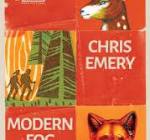
Chris Emery has said that, when completing the final details of Modern Fog, his fourth collection, twenty-three years after his first, it felt like another debut: “it feels as if these are the very first words, something spoken under the breath at a crossroads where you scan the bare, disturbed fields and make your choice in the hard wind – to find a new path, to head out again towards that darker line of trees.”
This is because the collection came out of a period of release in terms of his writing in which several new themes emerged. This period of his life began when he left publishing to become Director of Operations of The Shrine of Our Lady of Walsingham – “a Marian shrine with its origins in the Middle Ages”. This was a move that he characterised at the time as being one of serving Christ.
The new themes he found included writing about spirituality, something, he once thought he would never do, and mystery – “the mystery of place, the mystery of the Other, the mystery of ourselves”. Additionally, he had “fallen in love with writing about the natural world”, and the landscape of Norfolk therefore features heavily in these poems.
While he left the Shrine over two years ago and says that “another version of myself has since emerged”, nevertheless Modern Fog, through its “poems about landscape and animals and distant fictions” is primarily a collection about giving up “on who you think you are”, “to become something new, something estranged, maybe even something redeemed from the silly paraphernalia of midlife identity” – a time when a new vulnerability can emerge.
In Radio Nostalgia, his second collection, Emery wrote that:
Together we are a modern fog,
the idea of the better dead, immortalised grey
eyes above subtitled totally idealised dialogue.
The American poet Forrest Gander suggested that Radio Nostalgia “opens a way into wakefulness” with “a stunning lexicon” containing “short phrases stuffed with grit, petrol and spleen”, as Emery refuses to look away from “a twenty-first century so wounded and blout that only the language that crawls over it shimmers with its implicit hope for transformation and redemption”. This description also seems relevant to Modern Fog; both in style and intent.
Now Emery writes of ‘six hundred years of stone / that break upon the modern fog’. In doing so, he is writing of St Helen’s Ranworth, the ‘Cathedral of the Broads’, around and within which he journeys in a sequence of twelve tower-shaped poems that form a central pillar to this collection.
As he views the panel paintings of the twelve Apostles at St Helen’s he marvels:
how
it has survived its own cause
and downfall to reach us, the story that
holds the story, the matter of it
that reaches us from a common tree,
a thriving binding root.
‘Ranworth sheds / its gold deliveries’ and these include:
Back there, inside the vestigial,
apostles of the inundation
stand neatly pinned in oak,
thin light knits, then spreads.
As a result, he wants ‘to stitch my dark / to yours inside a river ritual’:
Something the walls may
register above the dry piscina there
a thousand years from now.
Something I will not understand
but still impart.
‘The Path’ seems to sum up most fully the journey he undertakes in this collection as he and his companion go ‘picking their way / through whin and leaf mould along the path’. They walk along ‘dirt paths alone’ through ‘all that hot wheat falling / and chalk beds, the clay beds, sinking / through each gold afternoon’ up ‘to the king oak’:
Somehow we will reach it, planting a quarterstaff
to recognise a new path …
I have led you here through all possible music
for something we cannot wholly know
and you will pull up my hand and kiss it
and carefully we walk on.
John Hartley Williams, to whom Emery’s work has sometimes been compared, wrote that Emery ‘possesses an attack vocabulary and has the ambition to think the unthinkable’. With this collection, as it follows Emery’s own path, it may be that intuitions of spirituality in sacred spaces become the unthinkable that is experienced, shaped and shared.
Jonathan Evens 13th February 2024
